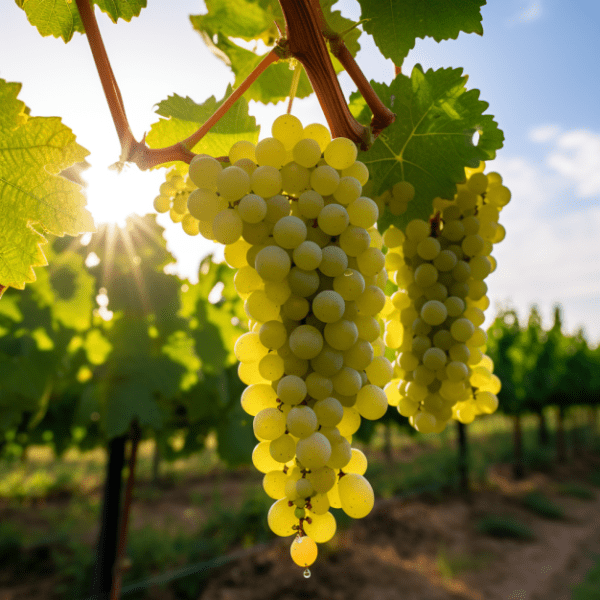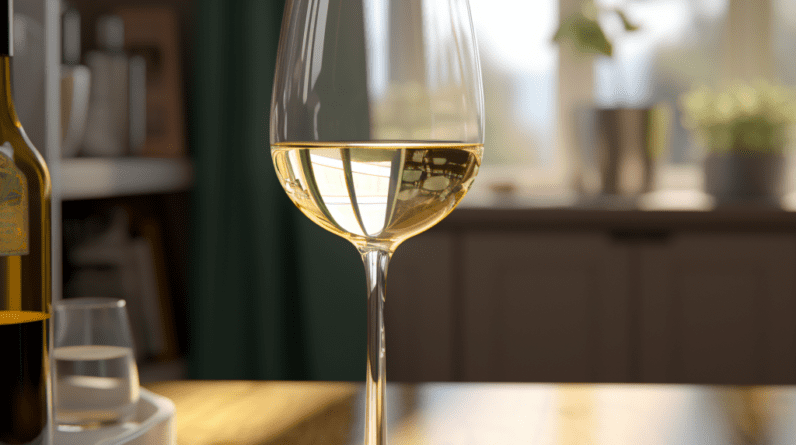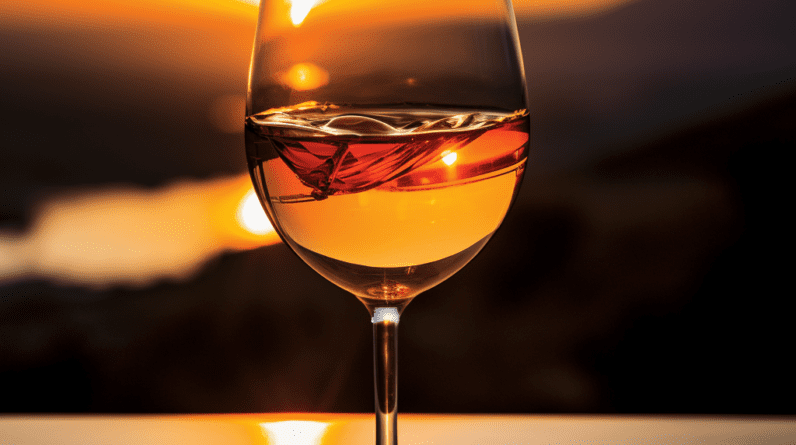
Diving into the world of wines?
Intriguing, isn’t it?
But, it can also feel overwhelming with the sheer range of white wine varieties at your fingertips.
For a budding wine enthusiast like you, the key is to start with the basics.
Let’s simplify the white wine maze and guide you to a bottle that’ll dance delightfully on your palate.
Understanding White Wine Varieties and Sweetness Levels
Overview of Varietals:
There are around 40 types. But don’t fret.
The giants in this space?
Chardonnay, Viognier, Chablis, and Trebbiano.
Ever noticed a name prominently displayed on your wine label? That’s the varietal, indicating the primary grape hero.

Classification by Sweetness and Flavor Profile:
Bold & Dry: Imagine a strong flavor. Now add some oak aging drama.
That’s this category.
Top picks: Chardonnay, Viognier, Trebbiano.
Light & Dry: Think of a light-bodied drink.
Fresh. Clean. Yup, that’s it.
Go-tos: Pinot Grigio, Chablis, Chenin Blanc.
Herbaceous: Ever sipped a wine and felt a garden whisper?
That’s this light-bodied category with “green” vibes. Great for herb-dishes.
Stars: Grüner Veltliner, Sauvignon, Vinho Verde.
Light & Sweet: A hint of sugar. But a blast of aroma.
Must-tries: Riesling, Moscato, Moschofilero.
Bold & Sweet: The grandeur of flavors.
Think desserts.
Favorites: Ice Wine, Tokaji, Malvasia.
Recommended White Wines for Beginners:
Embarking on your wine journey? Start strong.
Chardonnay: Dive into a White Wine Favorite
Ever tasted Chardonnay?
Silky. Mellow. The hint of oak?
Simply wow. Pair it with chicken or fish.
Or imagine it with creamy salmon. Spot on!

Warm weather calls for a toast. With what?
Chardonnay, of course.
It’s loved all over the world.
Bet you didn’t know that Chardonnay grapes are super popular!
They’re everywhere. And guess what? They’re not just for wine.
They’re a big deal in making Champagne. Yes, that bubbly party drink.
It all started in Burgundy, France.
Ever heard of Pinot Noir? Same place.
Chardonnay’s history? As rich as its flavor.
With its huge fan base, no wonder these grapes are grown everywhere wines are made.
But here’s a tip.
Every Chardonnay bottle isn’t the same.
You’ve got two types: oak-aged and unoaked.
Both are yummy. The oak one? Creamy and lush.
The unoaked? Crisp and dry.
Take a sip. Taste the fruits?
Apple, melon, passionfruit, maybe some pineapple and pear.
And don’t miss out on the lemony tang, the sweet honeysuckle, the salty hint, the almond crunch, and the soft scent of jasmine.
If you’ve got an oak-aged glass, there’s more.
You might taste vanilla. Or butter. Perhaps pie crust.
Or even that fancy crème brûlée dessert.
Lastly, think about its body and tang.
Chardonnay feels rich.
Depending on its aging, it might be softly tart (like the oak-aged ones) or a bit more tangy (like the unoaked ones).
Next time you sip Chardonnay, think about its journey.
From grape to glass. And all those flavors. Cheers to that!
Looking for your perfect Chardonnay glass? Check these out!
Prosecco: The Italian Answer to Champagne
Prosecco: Italy’s sparkling gift.
A tad sweet, bursting with fruity and floral whispers.
Cured meats? Yes. But Pad Thai? Mind-blowing.

When the fizz and clink of sparkling wine beckon, but the exorbitant price of Champagne nudges you away, what do you reach for?
For many, that answer is Prosecco.
The allure of Champagne is undeniable.
It’s the epitome of luxury, taste, and celebration.
However, if one’s pocket doesn’t align with these aspirations, you might feel limited.
Enter Prosecco, the Italian hero of sparkling wines that doesn’t dent your wallet yet delights your palate.
Less pricey than its French counterpart, Prosecco stands tall, not as a “budget” option, but as a drink of choice in its own right.
It’s easy to label Prosecco as Italy’s answer to Champagne.
But a deeper delve uncovers the nuances that differentiate them.
Origin and Terroir: First and foremost, their homelands.
While Champagne hails from the Champagne region of France, Prosecco is a proud product of Italy.
Grape Variety: The foundation of their unique flavors is the grapes.
Champagne is typically crafted from Chardonnay, Pinot Noir, and Pinot Meunier grapes.
Prosecco, on the other hand, is predominantly made using the Glera grape, lending it its distinctive taste.
Production Technique: Here lies the most significant divergence.
Champagne undergoes a meticulous fermentation process in the very bottle you pour from.
This method, known as the ‘Traditional Method’, imparts to Champagne its characteristic yeasty undertones.
Prosecco opts for a more contemporary approach, employing the ‘Tank Method’ or ‘Charmat Method’.
Here, after introducing sugar and yeast, the wine is fermented in large tanks.
This not only expedites the production, making it cost-effective, but also yields a sparkling wine with a fresh, fruit-forward profile, without the pronounced yeasty flavor.
To the untrained palate, Prosecco and Champagne might seem like sparkling sisters, but the discerning drinker recognizes each for their unique strengths and identities.
So, the next time you find yourself yearning for some bubbles without burning a hole in your pocket, raise a glass of Prosecco and toast to its Italian charm.
Pinot Grigio: The Sunshine Sipper
Pinot Grigio: Dry, crisp. A slight acidic tickle. Chinese dishes beckon.

Amid the vast tapestry of white wines available, Pinot Grigio—or Pinot Gris, as it’s lovingly called in France—stands out as a refreshing favorite for many, especially under the summer sun.
The wine’s zesty charisma has secured its spot among the top white wines enjoyed in the United States, offering a breezy counterpoint to the scorching heat.
Pinot Grigio traces its lineage to the iconic Pinot grape, a cornerstone of the wine world that also gives us the famed Pinot Noir and Pinot Blanc.
Despite its familial ties to these esteemed wines, Pinot Grigio often finds itself brushed aside by connoisseurs, who criticize it for its perceived simplicity.
But, in the world of wines, simplicity can be an asset.
For those who prefer their wine experience unpretentious and in the moment, Pinot Grigio emerges as a cherished companion for laid-back, sunny afternoons.
The taste of Pinot Grigio is as varied as the regions that nurture its vines.
With Italy and France as its main cultivating grounds, the wine’s profile often dances between these two cultures:
Common Characteristics: No matter its origin, a hallmark of Pinot Grigio is its dry demeanor, underscored by a lively acidity.
For those with a penchant for sweet, this might come as a sharp contrast.
The wine bursts with fruity exuberance, treating your palate to a riot of lime, green apple, lemon, pear, and nectarine.
To balance the fruitiness, subtle floral, spicy, and salty notes whisper in the background, creating a well-rounded flavor experience.
The Italian vs. French Divide: Distinguishing between an Italian Pinot Grigio and its French counterpart is an exercise in nuance.
Wines from Italy lean more towards the dry and slightly bitter spectrum.
In contrast, the French rendition tends to be a touch sweeter, caressing the taste buds with a hint of honey.
So, the next time the sun’s rays invite you for an alfresco experience, pour yourself a chilled glass of Pinot Grigio.
As the world slows down around you, let its crisp notes elevate your day.
Whether you’re a wine aficionado or someone who simply enjoys a good drink, Pinot Grigio promises a refreshing journey with every sip.
Moscato: A Sweet Symphony of Flavors
Moscato: Sweet meets fruity. And that musky hint? Unique.
For a wild ride, pair it with spicy Asian dishes.

Moscato, with its signature sweetness, remains one of the most talked-about wines in the white wine panorama.
Its very essence, derived from the sugary Muscat grape, has polarized wine enthusiasts.
While many are enchanted by its sugary symphony, others find its sweetness a tad overwhelming.
But, what makes the Moscato experience truly special is its rich lineage and the versatility it brings to the table.
Muscat grapes, believed to have roots in ancient Egypt, stand tall as one of the world’s oldest grape varieties.
Their rich history has seen them flourish in diverse terrains, from the sun-kissed vineyards of Italy and France to the expansive landscapes of the U.S.A, Spain, and South Africa.
It’s a testament to the grape’s adaptability and global appeal.
Furthermore, the Muscat grape, with its natural sugar richness, is among the few ‘noble grapes’ that can be savored in its raw form.
This inherent sweetness becomes the defining characteristic of the wines crafted from it.
Contrary to the singular image it might conjure, Moscato unfolds in multiple styles, each distinct in taste and character:
Sparkling Moscato: Divided into semi-sparkling (Moscato d’Asti) and fully sparkling (Asti Spumante), these effervescent variants are celebrated for their refreshing sweetness and bubbly texture.
Owing to strict origin classifications, only those from Italy’s fertile grounds can don these labels.
Still Moscato: A delightful blend of Muscat Blanc grapes and other related varieties, this wine offers a more traditional, non-sparkling experience.
Pink Moscato: A visual and taste spectacle, Pink Moscato derives its rosy hue and fruity sweetness from the combination of Muscat and Merlot grapes.
Red (Black) Muscat: A rarity in the world of wines, this variant is crafted from the elusive Black Muscat grape.
Dessert Moscato: The epitome of sweetness, these wines owe their character to partially dried Muscat grapes.
The flavor journey of Moscato, sculpted by the Muscat grape’s inherent sugariness, makes it an ideal companion for balmy summer afternoons.
Its palate boasts of luscious peaches and enchanting orange blossoms.
But, it doesn’t stop there.
Dive deeper, and hints of Meyer lemons, mandarins, honeysuckle, pears, and floral undertones rise to the fore.
With its light-bodied structure and a playful fizzy texture, Moscato promises a delightful escapade with every sip.
For those willing to embrace its sweetness, Moscato offers an unmatched wine experience—a timeless dance of history, versatility, and flavors.
Striving to find and describe all those wine aromas? This might help!
Riesling: Beyond Sweetness to Sophistication
Riesling: Light, but a burst of fresh apple notes. Fish, poultry, pork – it’s versatile.
Often, when people think of Riesling, their mind jumps straight to its sugary sweetness.
However, like many complex wines, Riesling is far more multifaceted and versatile than popular perceptions might lead one to believe.

While Chardonnay and Sauvignon Blanc might enjoy global acclaim, Riesling, emerging from the picturesque vineyards of Germany, has its own tale to tell.
This wine stands out not just for its flavors but also for its ability to absorb and express the characteristics of the terrain from which it hails.
The very essence of Riesling is a testament to the influences of the terroir in which it’s nurtured.
At its heart, Riesling is a celebration of fruit.
Every sip paints the palate with pronounced fruit flavors, where lively notes of limes, lemons, and pineapples converge with the mellow undertones of apricots, apples, and pears.
The inherent high acidity of Riesling acts as a counterpoint, weaving in a refreshing tartness that elevates its flavors.
But to simply label Riesling as a ‘sweet wine’ would be an oversimplification.
It’s a versatile wine that can gracefully stride the entire sweetness-to-dryness continuum.
From bone-dry varieties to those exuding syrupy sweetness, Riesling’s range is truly impressive.
For those who still hanker after that characteristic sweetness, German and Californian Rieslings are the ones to reach for.
The unique climates and soils in these regions coax out the inherent sweetness of the Riesling grape, resulting in wines that tantalize the taste buds with sugary notes.
On the other hand, if dry wines align more with your preferences, Rieslings from France, especially the Alsace region, and Austria are ideal choices.
These wines retain the fruity essence but are tempered with a crisp dryness.
Riesling, much like any other wine, is a reflection of its origins, cultivation, and the winemaking process.
So, before writing it off based on the myth of it being ‘just another sweet wine’, give it a chance.
Dive deep into its diverse spectrum, and you might just find a Riesling that resonates with your palate, be it sweet, dry, or somewhere in between.
Sauvignon Blanc: A Distinctive Delight of Whites
Sauvignon Blanc: Herbal magic.
From apples to mangoes, it’s a tropical roller coaster. Seafood. Poultry. Salads.
It’s got you covered.

In the realm of white wines, Sauvignon Blanc is undeniably an icon, standing tall with its unmistakable characteristics and deep-rooted history.
While it might hail from the picturesque regions of the Loire Valley and Bordeaux in France, it has since traveled the world, finding homes and avid enthusiasts in myriad terrains.
Tracing its lineage back to the verdant expanses of the Loire Valley and Bordeaux, the Sauvignon Blanc grape variety has adapted well to different geographies.
The grape flourishes in climates that are warm, yet not scorchingly hot.
This affinity for temperate climates has led to its successful cultivation in diverse regions like South Africa’s celebrated wine routes, the sun-kissed valleys of California, Australia’s vast vineyards, and of course, its French homeland.
The charm of Sauvignon Blanc lies in its extraordinary flavor profile.
It veers towards the green and herbaceous spectrum, an attribute seldom found so prominently in other whites.
It’s hard to miss the robust aromas reminiscent of freshly cut grass, nettles, and even the spiciness of green peppers and jalapeños.
But it’s not all about the greens.
Balancing its green notes, Sauvignon Blanc delights with its fruity undertones.
As you sip, the tangy zest of lime mingles with the crispness of tart apple, the juiciness of peaches, and the tropical allure of passion fruit.
For those who have a palate inclined towards sweeter wines, Sauvignon Blanc might come as a surprise.
Its marked dryness combined with a pronounced acidity can be a refreshing revelation for some, but it can also catch the uninitiated off guard with its briskness.
This combination can sometimes lead to a sharp, almost mouth-watering sensation, especially in bottles that lean more towards the acidic side.
Sauvignon Blanc is a journey of flavors, from its green herbaceous beginnings to its fruit-filled crescendos, all underscored by its unmistakable dryness and zest.
Whether you’re new to this variety or a seasoned connoisseur, every glass of Sauvignon Blanc promises a unique experience, one that resonates with its rich heritage and global journey.

Embarking on a White Wine Journey
Starting with white wine?
It’s more than just a drink. It’s an elegant introduction.
As you sip and savor, you’ll find every flavor opening a new chapter.
Wine isn’t just a drink; it’s a journey. And you?
You’re just getting started.
Decanting your wine? I love this decanter!
FAQ:
Q1: What’s a good white wine for someone who likes sweeter drinks?
A1: Prosecco and Moscato are great options.
They lean towards the sweeter spectrum, offering a delightful taste.
Q2: Which white wine is considered the most beginner-friendly?
A2: Chardonnay is a top pick for many.
Its velvety texture and oak-aged flavor make it an easy and enjoyable introduction.
Q3: How do I know the grape variety in my wine?
A3: Check the label.
The prominently displayed name, like Chardonnay or Pinot Grigio, indicates the primary grape.
Hope this helps on your wine journey. Cheers!
Resources:




